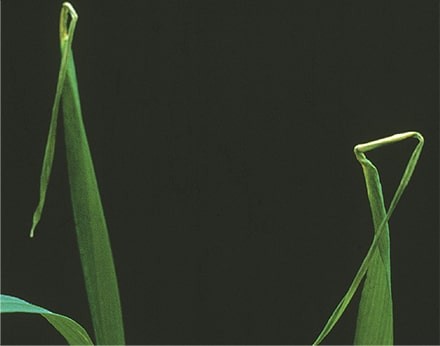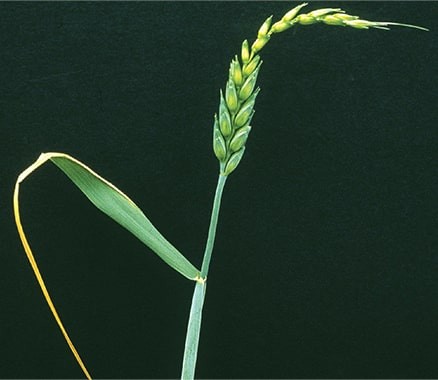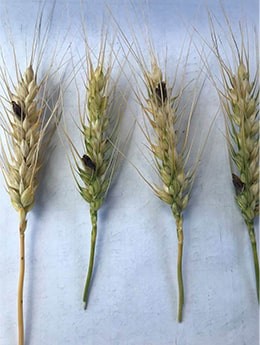Copper Deficiency is Common in Western Canada
Copper (Cu) is a micronutrient which is only needed in trace amounts, but is involved in several key plant actions, including photosynthesis, nitrogen utilization, protein production and water regulation. Copper deficiency is becoming more widespread across Western Canada, limiting a crop’s growth and reducing yield potential. In this post we will examine the role of copper in the plant, consequences of copper deficiency and solutions to provide cu to your crop.
Copper Deficiency in Western Canada
Many crops can be sensitive to copper deficiency including cereals, oilseeds, flax, corn and vegetable crops. Sensitivity varies among cereals, with wheat being the most sensitive, followed by barley, oats, triticale and rye.

Cereal crops have lower cu requirements compared to other crop types. Canola and other broad leaf crops require approximately three times the rate of cu that a cereal crop requires. Western Canadian soils have become more copper deficient than we may think, in part because the natural stores of copper have been depleted by plants which take up copper in higher amounts.
Is Your Soil at Risk?
Depending on your farm’s geography, your soil may also be more susceptible to deficiency of cu. A wide variety of soil types are prone to becoming deficient in cu, including sandy soils and alkaline soils with high pH levels. Soil that has received heavy manure application, soil that has excess N or P and peat or muck soils with high organic matter can all become deficient in cu.
Weathered soils or soil formed from parent material that was low in cu can be deficient. Also, heavily limed soils, soils with added molybdenum, sandy soils, leached acid soils and soils with a high concentration of manganese can all be prone to a copper deficiency.
As you can see, the list of soil types that are prone to this deficiency and the factors that can impact copper deficiency is quite extensive. I recommend soil testing at regular intervals to make sure your soil has adequate nutrients, including copper, available to your crops.

The Role of Copper in the Crop
Plants need adequate copper for lignin formation, which affects the overall strength of the plant, and is critical for proper seed formation. Inadequate copper levels in the plant can cause increased susceptibility to diseases including root-rot and ergot.

However, it can be difficult for young seedlings to access the copper they require. Cold conditions make P, K and micronutrients including Cu less available to crops. In spring 2020, parts of the Prairies are experiencing unseasonably cold temperatures well into May, so this may impact the availability of nutrients in your soil during seeding. Plants take up copper primarily through interception, the root must grow into the band to absorb the necessary Cu.
Symptoms of copper deficiency include chlorosis of the leaf margins and brown spots over the surface of the leaf (in broadleaf crops), pig tailing or whip tailing of older leaves (in cereals), stem dieback, lodging, delayed maturity, stunted growth, aborted heads, reduced or deformed seed, and poor yields.
Solutions for Copper Deficiency
If soil tests indicate a copper deficiency, or persistent conditions like cold weather limit the uptake of copper, consider using a primer, starter or foliar fertilizer to supply this micronutrient to your crop.
Primer Cu is formulated with high concentrations of phosphorus, potassium, zinc and copper. Applied to cereals prior to seeding, Primer Cu places essential micronutrients as close to the seed as possible, contributing to stronger roots and stems while preventing yield-limiting symptoms of deficiency.
Perfuze Cu is a highly concentrated suspension, designed to coat dry fertilizer blends, and is a cost-effective way to provide seedlings with in-soil micronutrients for a strong start and, ultimately, a faster finish.
Copper is also available in a single element formula. OMEX Cu can be used in-furrow with a starter or, when soil application is not possible, as a foliar. In-crop, OMEX Cu can be mixed with pesticides or other fertilizers and applied directly to the foliage to correct copper deficiency.
OMEX’s Foliar Advance Cu and Fortis are liquid foliar fertilizers, used to improve crop health and seed quality. They are a good source of readily available copper, formulated for quick absorption. Expect improved photosynthesis, reduced lodging, a high level of pollen fertility and a lowered chance of ergot.
Talk to your ag retailer or OMEX representative about when and how to use copper to alleviate deficiency and build a balanced plant nutrition program to improve the health and yield of your crop.
